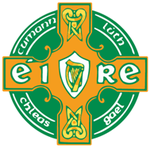Celtic cross
 |
 |
|
|
A simplified Celtic cross.
|
A simplified Celtic Christian cross.
|
A Celtic cross (Irish: cros Cheilteach,[1] Welsh: croes Celtaidd) is a symbol that combines a cross with a ring surrounding the intersection. In the Celtic Christian world it was combined with the Christian cross and this design was often used for high crosses – a free-standing cross made of stone and often richly decorated.[2] With the Celtic Revival the shape, usually decorated with interlace and other motifs from Insular art, became popular for funerary monuments and other uses, and has remained so, spreading well beyond the British Isles.
Contents |
Christian usage

In Ireland, it is a popular legend that the Celtic Catholic cross was introduced by Saint Patrick or possibly Saint Declan during his time converting the pagan Irish, though no examples survive from this early period. It has often been claimed that Patrick combined the symbol of Christianity with the sun cross, to give pagan followers an idea of the importance of the cross by linking it with the idea of the life-giving properties of the sun.[3] However this theory is now thought unlikely by most art historians, who think an origin from crosses carrying a victor's wreath around their intersection is more likely.[4] Such a cross is found on the reverse of the Liudhard medalet from Canterbury in England in the 590s.
In Celtic regions of Ireland and later in Great Britain, many free-standing upright crosses or high crosses were erected by Irish monks, beginning at least as early as the 7th century. Some of these 'Celtic' crosses bear inscriptions in runes. There are surviving free-standing crosses in Cornwall (famously St Piran's cross at Perranporth) and Wales, on the island of Iona and in the Hebrides, as well as the many in Ireland.[5] Other stone crosses are found in the former Northumbria and Scotland, and further south in England, where they merge with the similar Anglo-Saxon cross making tradition, in the Ruthwell Cross for example.
The most famous standing crosses are the Cross of Kells, County Meath, Ireland; Ardboe High Cross, Ardboe, County Tyrone, Northern Ireland; the crosses at Monasterboice, County Louth, Ireland; and the Cross of the Scriptures, Clonmacnoise, Ireland. The Celtic cross is often made of stone. After the 15th century, ringed high crosses ceased to be created in the Celtic lands, other than a few obscure examples.
The Celtic Revival of the mid-19th century led to an increased use and creation of Celtic crosses in Ireland. In 1853 casts of several historical high crosses were exhibited to interested crowds at the Dublin Industrial Exhibition. In 1857, Henry O'Neill published Illustrations of the Most Interesting of the Sculptured Crosses of Ancient Ireland. These two events stimulated interest in the Christian and non-Christian Celtic crosses as a symbol for a renewed sense of heritage within Ireland.
New versions of the high cross were designed as fashionable cemetery monuments in Victorian Dublin in the 1860s. From Dublin the revival spread to the rest of the country and beyond. Since the Celtic Revival, the ringed cross became an emblem of Celtic identity, in addition to its more traditional religious symbolism. [6] Alexander and Euphemia Ritchie, working on the Isle of Iona in Scotland from 1899 to 1940, popularized use of the Celtic Cross in jewellery. [7]
Other usage

Since its revival in the 1850s, the Celtic cross has been used extensively as grave markers. This was a departure from medieval usage, when the symbol was more typically used for a public monument. The Celtic cross now appears in jewellry, T-shirts, tattoos, coffee cups and other retail items. Both the Gaelic Athletic Association and the Northern Ireland national football team use versions of the Celtic cross in their logos and advertising.
The Celtic cross is one of the most popular symbols used by racist individuals and organizations to represent white pride.[8] In Germany, the Celtic cross was adopted by a prohibited neo-Nazi party (VSBD/PdA) leading to the ban of the symbol. Although there were doubts on the constitutionality of the ban[9] it was upheld in a decision of the supreme court.[10]
Celtic cross also refers to a common tarot card divination spread.
Notes
- ↑ http://www.focal.ie/Search.aspx?term=Celtic%20cross
- ↑ Werner 98
- ↑ Stephen Walker, "Celtic Cross History and Symbolism", Celtic Arts website, accessed 22 Nov 2008
- ↑ Wernher, 98
- ↑ Langdon, Arthur G. (1896) Old Cornish Crosses. Truro: J. Pollard
- ↑ Stephen Walker, "Celtic Revival Crosses", Celtic Arts Website, accessed 22 Nov 2008
- ↑ "A Brief History of the Ritchies", Alexander Ritchie Website, accessed 20 Nov 208
- ↑ "Hate Symbols: Celtic Cross - From A Visual Database of Extremist Symbols, Logos and Tattoos", Anti-Defamation League, accessed 23 Jul, 2010
- ↑ Andreas Stegbauer, "The Ban of Right-Wing Extremist Symbols according to Section 86a of the German Criminal Code", German Law Journal, No.2, 1 Feb 2007, accessed 22 Nov 2008
- ↑ http://juris.bundesgerichtshof.de/cgi-bin/rechtsprechung/document.py?Gericht=bgh&Art=pm&pm_nummer=0209/08
See also
- Solar symbol
- Sun cross
- Coptic cross
- Irminsul
- Maypole
- High cross
- Picture stone
References
- Werner, Martin (1990). "On the Origins of the Form of the Irish High Cross". Gresta (Gesta, Vol. 29, No. 1) 29 (1): 98–110. http://www.jstor.org/stable/767104. Retrieved 2009-05-22.